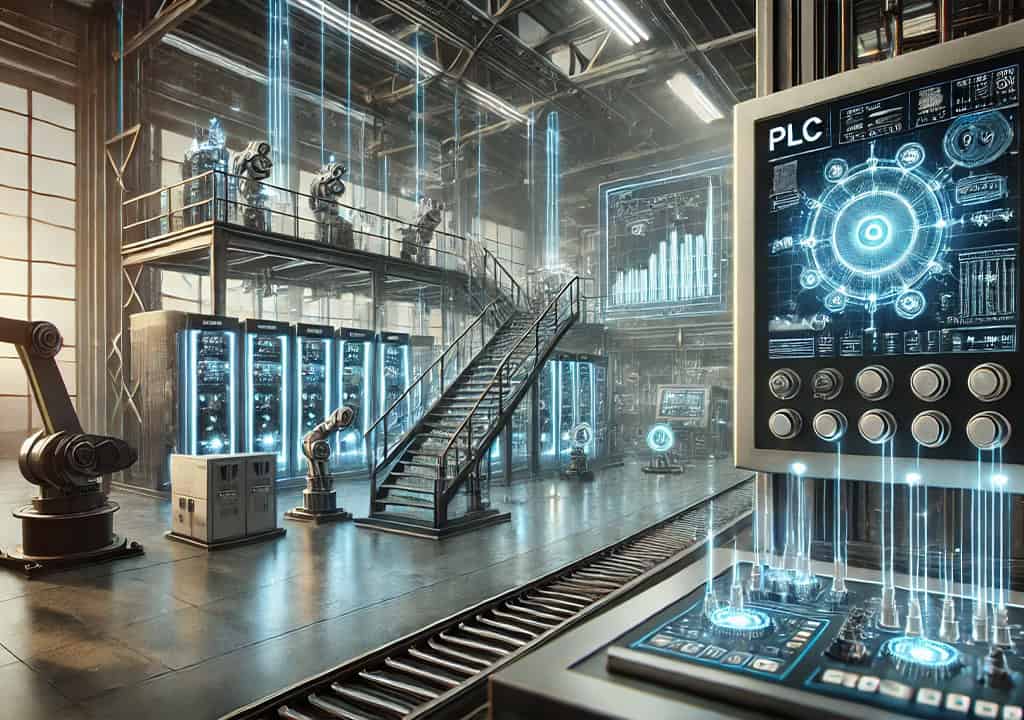Automation has revolutionized modern industries, allowing companies to increase efficiency, reduce human error, and improve overall productivity. At the core of most industrial automation systems are PLC (Programmable Logic Controller) and HMI (Human-Machine Interface) technologies. Together, they form the backbone of automated processes, enabling machines and systems to operate seamlessly while giving operators the ability to monitor and control these systems in real-time.
In this blog, we’ll explore the roles of PLCs and HMIs in modern industries and why they are critical to the future of automation.
What is a PLC?
A Programmable Logic Controller (PLC) is a specialized computer used to control machinery and processes in industrial environments. PLCs are designed to handle harsh conditions like extreme temperatures, humidity, and electrical noise, making them reliable for critical operations. Unlike traditional computers, PLCs can withstand these conditions while managing complex, real-time tasks.
Key Features of a PLC:
- Programmable Control: PLCs are highly flexible and can be programmed to control various processes such as motors, pumps, conveyors, and automated machines.
- Real-Time Operation: They operate in real-time, meaning they can respond immediately to inputs from sensors and other devices to ensure smooth, continuous operations.
- Reliability and Durability: Designed for the rugged industrial environment, PLCs are built to withstand dust, heat, and vibrations, ensuring minimal downtime.
- Scalability: PLCs are scalable, allowing companies to expand their automation systems as needed by adding more inputs and outputs or integrating more complex control strategies.
What is an HMI?
A Human-Machine Interface (HMI) is the visual interface that allows operators to interact with the machines or processes controlled by the PLC. The HMI provides real-time data, such as temperature, pressure, machine status, and alarms, through intuitive displays. Operators use the HMI to monitor processes, adjust parameters, and troubleshoot issues, all in real time.
Key Features of an HMI:
- Visualization of Data: HMIs present complex data from machines and systems in an easily understandable format, such as graphs, charts, or icons.
- Control Functions: Through the HMI, operators can control machine functions, making adjustments like increasing speeds, resetting alarms, or changing setpoints.
- Alarm Management: The HMI displays alarms and alerts in case of system failures, allowing operators to take immediate corrective actions.
- User-Friendly Interface: HMIs are designed to be user-friendly, often incorporating touchscreens and simplified layouts to make navigation and control easier for operators.
How PLC & HMI Work Together
In industrial automation systems, PLCs and HMIs work together to create a seamless control and monitoring experience. The PLC acts as the brain of the system, processing inputs from sensors and other devices and then controlling outputs such as motors, pumps, or valves. Meanwhile, the HMI serves as the user interface, providing a way for operators to interact with the system without having to directly manipulate the PLC’s internal workings.
For example, in a manufacturing plant, the PLC may be controlling the speed of a conveyor belt. The operator, using the HMI, can view the current speed and adjust it if necessary. If an issue arises, like a motor overheating, the HMI will display an alarm, and the operator can use the HMI to shut down the system and troubleshoot the problem.
Together, these two systems offer a powerful, real-time solution for controlling and monitoring industrial processes efficiently.
The Role of PLC & HMI in Modern Industries
PLC and HMI systems are used in a wide variety of industries, from manufacturing and power generation to food processing and water treatment. Here’s how they are transforming modern industries:
1. Enhanced Efficiency
With automation systems powered by PLCs and HMIs, industries can significantly enhance their operational efficiency. Processes that once required manual intervention are now automated, allowing machines to run 24/7 with minimal downtime. Operators can make real-time adjustments via HMIs, ensuring that production runs smoothly and efficiently.
2. Reduced Human Error
Manual processes are prone to human error, which can lead to costly mistakes, downtime, or even safety hazards. Automation via PLCs minimizes human intervention, thereby reducing the risk of errors. The HMI also provides immediate feedback and alerts, helping operators spot potential issues before they become major problems.
3. Increased Flexibility
One of the greatest benefits of PLCs is their ability to be reprogrammed for different tasks. This makes them highly versatile in industries where processes change frequently or where new machinery is introduced. Paired with an intuitive HMI, operators can quickly adjust to new conditions without needing extensive training or additional equipment.
4. Improved Safety
Safety is a top priority in industries like manufacturing, mining, and oil & gas. PLCs are equipped with fail-safes and safety protocols that shut down systems in case of critical failures, preventing accidents. HMIs provide operators with real-time data about the health of the system, ensuring they can take immediate action in emergency situations.
5. Data Collection and Analysis
In modern industrial environments, data is king. PLCs can collect vast amounts of data about machine performance, energy usage, and production rates, which can be visualized and analyzed through the HMI. This data can help managers identify inefficiencies, predict maintenance needs, and optimize overall production.
Future Trends in Automation: Smart PLCs and Advanced HMIs
As industries move toward greater automation and digitization, the role of PLCs and HMIs is evolving. Smart PLCs, which incorporate AI and IoT (Internet of Things) technology, are becoming more common, enabling machines to communicate with each other and make decisions without human intervention. These systems can predict equipment failures, optimize energy use, and adjust production schedules in real-time.
HMIs are also advancing, with 3D visualization and augmented reality (AR) becoming part of the user experience. This allows operators to visualize complex processes in greater detail, making it easier to troubleshoot issues and maintain systems efficiently.
Conclusion
PLCs and HMIs are at the heart of modern industrial automation, providing robust, reliable control systems for everything from manufacturing plants to power grids. By allowing for seamless control, real-time monitoring, and data-driven decision-making, these technologies have become indispensable in driving industrial efficiency, safety, and innovation.
At Trust Deal, we specialize in providing high-quality PLCs and HMIs to meet the needs of diverse industries. Whether you’re looking to automate a single process or integrate an entire system, our team of experts can help you choose the right automation solution for your business. Contact us today to learn more about how we can support your automation goals.





